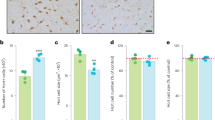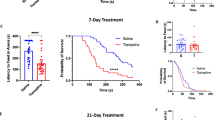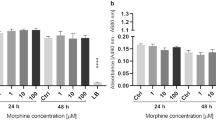Abstract
Despite recent advances1,2, relatively little is known of the mechanism of action of opiate analgesics at the cellular level. There is evidence, however, that the inhibition of neurotransmitter release produced by morphine may be mediated by the initial release of adenosine3–5; the effect is mimicked by adenosine and the actions of both adenosine and morphine are blocked by theophylline and enhanced by dipyridamole3–5. When applied microiontophoretically, adenosine has also been shown to be a potent depressant of the firing rate of single neurones in the mammalian brain, and a similar depressant effect of morphine has been claimed to be stereospecific, antagonised by naloxone6–9 and greatly reduced in animals made tolerant to, and dependent on, morphine8,9. The experiments described here examine the effect of aminophylline, a soluble theophylline derivative, on these depressant effects. We have found that aminophylline will block responses to both morphine and adenosine, suggesting that the depressant responses to morphine may also be mediated by the local release of adenosine.
This is a preview of subscription content, access via your institution
Access options
Subscribe to this journal
Receive 51 print issues and online access
$199.00 per year
only $3.90 per issue
Buy this article
- Purchase on SpringerLink
- Instant access to full article PDF
Prices may be subject to local taxes which are calculated during checkout
Similar content being viewed by others
References
Kosterlitz, H. W. (ed.) Opiates and Endogenous Opioid Peptides (North-Holland, Amsterdam, 1976).
Hughes, J. (ed). Centrally Acting Peptides (Macmillan, London, 1978).
Gintzler, A. R. & Musacchio, J. M. J. Pharmac. exp. Ther. 194, 575–582 (1975).
Jhamandas, K., Sawynok, J. & Sutak, M. Eur. J. Pharmac. 49, 309–312 (1978).
Sawynok, J. & Jhamandas, K. H. J. Pharmac. exp. Ther. 197, 379–390 (1976).
Bradley, P. B., Briggs, I., Gayton, R. J. & Lambert, R. A. Nature 261, 425–426 (1976).
Young, W. S., Bird, S. J. & Kuhar, M. J. Brain Res. 129, 366–370 (1977).
Satoh, M., Zieglgänsberger, W., Fries, W. & Herz, A. Brain Res. 82, 378–382 (1974).
Zieglgänsberger, W., Fry, J. P., Herz, A., Moroder, L. & Wunsch, E. Brain Res. 115, 160–164 (1976).
DeGroot, T. Trans. R. Neth. Acad. Sci. 52, 1–40 (1959).
Stone, T. W. J. Physiol., Lond. 233, 211–225 (1973).
Stone, T. W. & Taylor, D. A. J. Physiol., Lond. 266, 523–543 (1977).
Pert, C. B. & Snyder, S. H. Science 179, 1011–1014 (1976).
Goldstein, A. Life Sci. 14, 615 (1974).
Lord, J. A. H., Waterfield, A. A., Hughes, J. & Kosterlitz, H. W. Nature 267, 495–499 (1977).
Phillis, J. W., Kostopoulos, G. K. & Limacher, J. J. Can. J. Physiol. Pharmac. 52, 1226–1229 (1974).
Kostopoulos, G. K. & Phillis, J. W. Expl Neurol. 55, 719–724 (1977).
Taylor, D. A. & Stone, T. W. Experientia 34, 481–482 (1978).
Stone, T. W. Biochem. Soc. Trans. 6, 858–862 (1978).
Sattin, A. & Rall, T. W. Molec. Pharmac. 6, 13–23 (1970).
Blume, A. J., Dalton, C. & Sheppard, H. Proc. natn. Acad. Sci. U.S.A. 70, 3099–3102 (1973).
Green, R. D. & Stanberry, L. R. Biochem. Pharmac. 26, 37–43 (1977).
Fredholm, B. B. & Vernet, L. Acta. physiol. scand. 104, 502–504 (1978).
Edstrom, J. P. & Phillis, J. W. Can. J. Physiol. Pharmac. 54, 787–790 (1976).
Zieglgänsberger, W. & Puil, E. A. Expl Brain Res. 17, 35–49 (1973).
Ho, I. K., Loh, H. H. & Leong Way, E. J. Pharmac. exp. Ther. 185, 336–346 (1973).
Ally, A. I. et al. Prostaglandins 14, 109–118 (1977).
Karmali, R. A. et al. Res. Commun chem. Path. Pharmac. 19, 181–184 (1978).
Collier, H. O. J. & Roy, A. C. Nature 248, 24–27 (1974).
Havemann, U. & Kuschinsky, K. Archs pharmac. 302, 103–106 (1978).
Collier, H. O.J., Francis, D. L. & Roy, A. C. Adv. Biochem. Psychopharmac. 15, 337–345 (1976).
Author information
Authors and Affiliations
Rights and permissions
About this article
Cite this article
Stone, T., Perkins, M. Is adenosine the mediator of opiate action on neuronal firing rate?. Nature 281, 227–228 (1979). https://doi.org/10.1038/281227a0
Received:
Accepted:
Published:
Issue date:
DOI: https://doi.org/10.1038/281227a0
This article is cited by
-
Cyclic nucleotides and aminophylline produce different effects on nociceptive motor and sensory responses in the rat spinal cord
Naunyn-Schmiedeberg's Archives of Pharmacology (1984)
-
Changes in the activity of nigral neurones induced by morphine and other opiates in rats with an intact brain and after prenigral decerebration
Naunyn-Schmiedeberg's Archives of Pharmacology (1981)
-
Cellular site of opiate dependence
Nature (1980)



